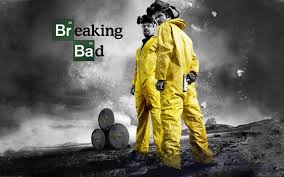The Pathos of Breaking Bad (Part 3)
By Asher Crispe: February 18, 2014: Category Inspirations, Quilt of Translations
 How low can you go? Using the language of highs and lows to denote a moral, spiritual or ethical dimension in life has far reaching implications in the Torah. The lowest of levels distinguishes itself as being bottomed out. To put it differently, height no long seems to exist. A psychological place at the lowest of lows–the nadir–is represented by the reduction of life as we know it to the material world. In this view, materialism is the totality of what is. The implications of this show themselves in the fact of Walter White being a die hard materialist (presumably) influenced by his chemistry background. When you break things down to their physical, elementary parts, all of those elements are the same for you and me, for the chair and the table. It’s all just atoms and molecules from this perspective.
How low can you go? Using the language of highs and lows to denote a moral, spiritual or ethical dimension in life has far reaching implications in the Torah. The lowest of levels distinguishes itself as being bottomed out. To put it differently, height no long seems to exist. A psychological place at the lowest of lows–the nadir–is represented by the reduction of life as we know it to the material world. In this view, materialism is the totality of what is. The implications of this show themselves in the fact of Walter White being a die hard materialist (presumably) influenced by his chemistry background. When you break things down to their physical, elementary parts, all of those elements are the same for you and me, for the chair and the table. It’s all just atoms and molecules from this perspective.
One of the more unpleasant tasks that is associated with the body count that Walter starts to rack up, is the disposal of the corpses. Not wanting to get caught by the police, he and others adopt a standard practice of dissolving the bodies in acid. As far as the viewing audience is concerned, human beings are reducible to bags of chemicals. Breaking ‘bad’ means losing all structure that would identify a person or thing as that person or thing. When the differentiation is gone we revert to being an undifferentiated blob of bio-mass. In essence, identity is dissolved into sameness.
This also holds true for our moral distinctions. When a value system is eroded, the criteria for choosing one course of action over another suddenly eludes us. Nothing is nailed down. Desert wind has swept away all of the lines in the sand which we drew. Eventually, life and death, good deeds and crime, become a ‘matter’ of indifference. When totally apathy is reached, then the descent is complete. There are no moral imperatives anymore. Everything is a rationalization. It’s all just opinion and all opinions have the same credence. Those who have followed the story from beginning to end sense that Walt is at or near this lowest place by the conclusion of the series.
Transposing this into topological terms, in the symbolism of Kabbalah, mountains represent the vertical dimension of existence. More abstractly, the vertical alludes to the idea of hierarchy. No two things are at the same level. Our individualization springs from our relative position on the mountain. By contrast, plains can be generalized as someplace totally flat, which suggests the horizontal dimension wherein everything that was coming down the mountain now tends towards equality and which, upon arrival at the bottom, becomes equalized. Everything turning equal and interchangeable might also be described as anarchy.
Where do we derive the existence of the vertical and the associate hierarchy of values that serve to guide out decisions? Innate human rationality and logic tend to balance equations and place all ideas on an equal footing. Every idea is immanent to a person’s understanding (binah). Searching for transcendental principles leads us above and beyond ourselves to a foundational memory, a revelation which derives from the wisdom of the past (chochmah).
Our decisions are too often seduced by the games of ‘instrumental reason’ which already politicizes ethical and spiritual life and subjects our thought processes to self-serving ends. Rationalizations grow from ‘special interest groups’ of ideas that lobby in the congressional chambers of the mind. Winning begins to replace being right. Reaching for the source text of those firm values or categorical imperatives–the anchors of our morality–we may follow the bread crumbs back to the Torah and to the Ten Commandments.
Of the ‘big’ Ten, the announcement of Divinity as the basis for our freedom is already established with the first of them. “I am the Lord your God, who brought you out of the land of Egypt from the house of slaves” (Exodus/Shemot 20:2) attests to a transcendental origin that founds universal values but which is not subject to the erosion of the natural world. Extracting a people from bondage with pomp and circumstance, exhibits a source of value that defies all ‘worldly’ definition. Such revelations are not on par with other events. It has to come from ‘on high’.
If we zoom in on the first word of this verse in Hebrew, it begins with a special variant of the first person pronoun (normally we encounter the word ani as ‘I’ but here we get the word anochi). By inserting Himself into the picture, God acts to provide a metaphysical basis for the code of conduct that would follow. In the Talmud, we find an interesting reference to a construction tool called a plummet (usually a piece of tin, lead or some other metal tied to the end of string which would drop down and hang next to a wall to determine if it was built straight up and down). Rooted in the word anochi (I) is the work anach meaning ‘plummet’. Due to this relationship, the very same letters of anochi (Alef-Nun-Kaf-Yud) have taken on another meaning when they are vocalized differently as ‘anachi’ which denotes ‘verticality’.
With God as the grantor, the installation of the vertical dimension into reality gifted us with a transcendental hierarchy of values which could not be moved or swayed by the winds of popularity nor the changing times. In addition to morality, it is worth noting how an established hierarchy is required in order for science to get off the ground. As pursuers of objective knowledge, scientists must follow some kind of pre-established protocols for determining right from wrong answers. Of course the broader context of this executive platform occurs on Mount Sinai which is itself an allusion to verticality. Torah as law and instruction derives from the communication of and upon this seminal hierarchy. The main event of the Torah is the installation of verticality as a permanent fixture of our daily lives.
The remembrance of the Sinaitic revelation cultivates our sense of right and wrong but it requires that we reclaim the best of the past. Without it we might succumb to the Nietzschean thoughts of exceptionalism which stroke the ego as was the case of Walter White. His moral debacles can never be solved once he has gone all the way down hill. There is no higher authority to appeal to. In the absence of God, the self may undergo an inflationary stage whereby the new deified individual acts as though he or she has the final word. Individuals who take exception to be the rule of law and who excuse themselves from moral pacts on account of their special talents or abilities, are susceptible to the ubermensch syndrome. Walt makes these mistakes fictionally but some–such as the infamous case in the 1920s of Leopold and Loeb (two wealthy law students at the University of Chicago) who thought that it would make an informative experiment to go out and murder a young boy–stumble with this issue for real.
 For the Talmudic sages, the commandments in the Torah could be sometimes classified as mishpatim or rational laws (i.e. laws that the human mind could deduce all by itself as part of the social contract of a functional and healthy society) or on the other extreme, they could be considered chukim (which are super-rational laws that exceed the grasp of logic and reason). Prohibitions against murder and stealing normally fall into the former category while perplexing commandments such as the kosher dietary laws land in the latter. However, the sages add one additional stipulation which files all commandments (including ‘do not kill’) in the super-rational column. This is to safeguard a person who has been thrown into a fit of temporary insanity (for whom the rationale for not killing suddenly cannot be found). We are reminded that we are to observe these statutes no matter what. Misappropriated ‘reason’ cannot uproot them. In this way, the elevation of all commonsense ethical behavior to the level of an unconditional imperative, inoculates a person against the self-deceiving rationalization of the Walter Whites of the world.
For the Talmudic sages, the commandments in the Torah could be sometimes classified as mishpatim or rational laws (i.e. laws that the human mind could deduce all by itself as part of the social contract of a functional and healthy society) or on the other extreme, they could be considered chukim (which are super-rational laws that exceed the grasp of logic and reason). Prohibitions against murder and stealing normally fall into the former category while perplexing commandments such as the kosher dietary laws land in the latter. However, the sages add one additional stipulation which files all commandments (including ‘do not kill’) in the super-rational column. This is to safeguard a person who has been thrown into a fit of temporary insanity (for whom the rationale for not killing suddenly cannot be found). We are reminded that we are to observe these statutes no matter what. Misappropriated ‘reason’ cannot uproot them. In this way, the elevation of all commonsense ethical behavior to the level of an unconditional imperative, inoculates a person against the self-deceiving rationalization of the Walter Whites of the world.
Breaking Bad slowly introduces us to Walt’s alter ego–the notorious criminal mastermind known on the street as Heisenberg. For Part Four in our series we will explore the spiritual significance of this new persona and the powerful lessons that it holds.
http://www.interinclusion.org/inspirations/the-pathos-of-breaking-bad-part-4/
http://www.interinclusion.org/inspirations/the-pathos-of-breaking-bad-part-2/
The Pathos of Breaking Bad (Part 3),













;)
;)
;)
;)
;)
;)
;)
;)
;)
;)
